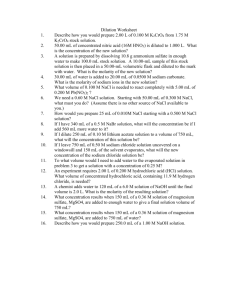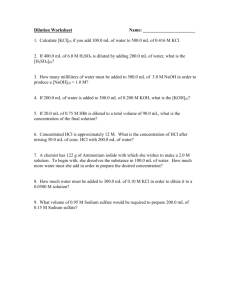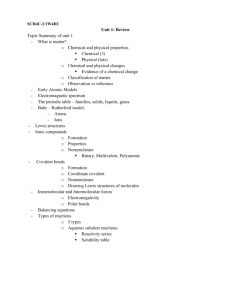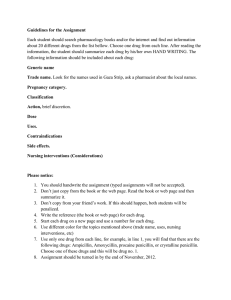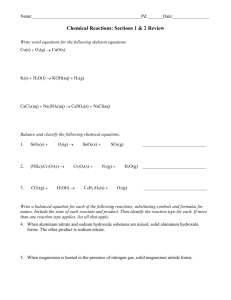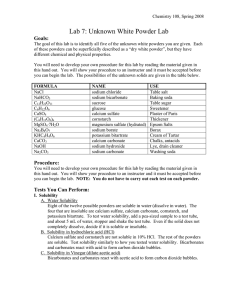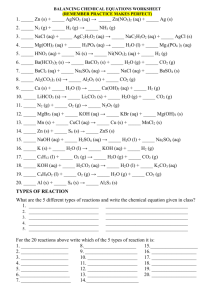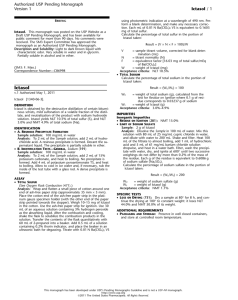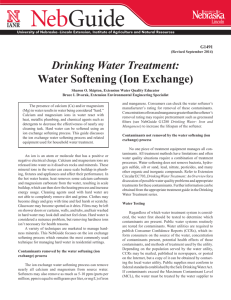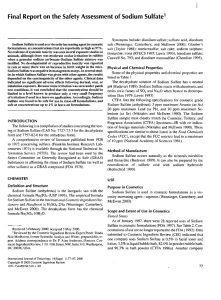Grade 12C Chemistry Review
advertisement
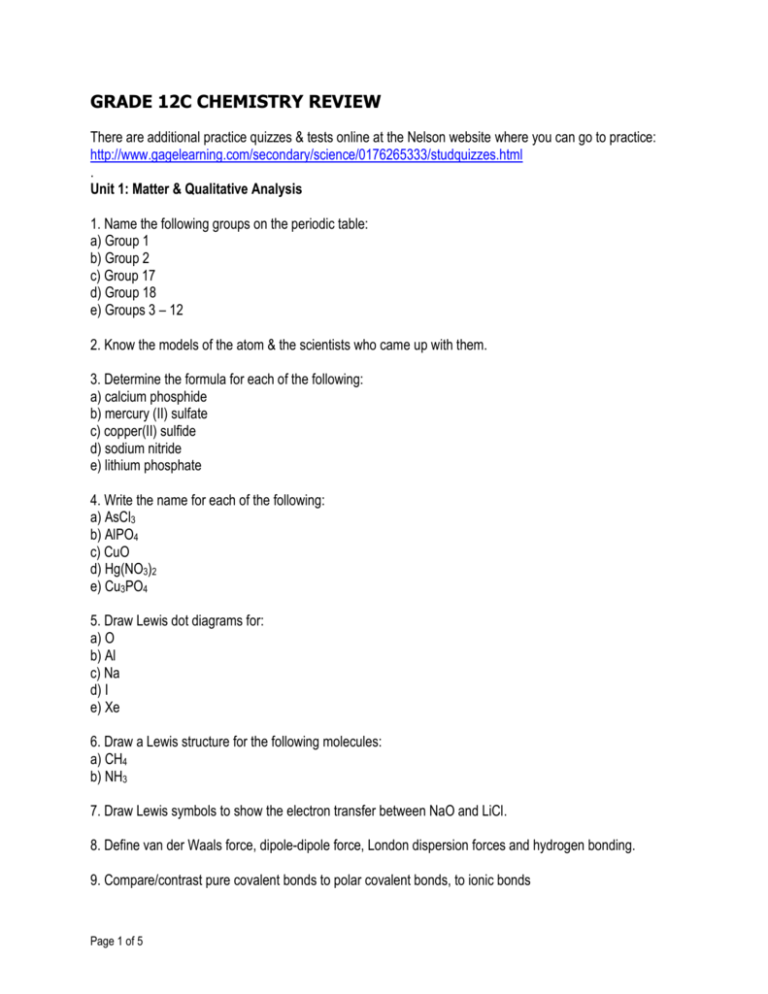
GRADE 12C CHEMISTRY REVIEW There are additional practice quizzes & tests online at the Nelson website where you can go to practice: http://www.gagelearning.com/secondary/science/0176265333/studquizzes.html . Unit 1: Matter & Qualitative Analysis 1. Name the following groups on the periodic table: a) Group 1 b) Group 2 c) Group 17 d) Group 18 e) Groups 3 – 12 2. Know the models of the atom & the scientists who came up with them. 3. Determine the formula for each of the following: a) calcium phosphide b) mercury (II) sulfate c) copper(II) sulfide d) sodium nitride e) lithium phosphate 4. Write the name for each of the following: a) AsCl3 b) AlPO4 c) CuO d) Hg(NO3)2 e) Cu3PO4 5. Draw Lewis dot diagrams for: a) O b) Al c) Na d) I e) Xe 6. Draw a Lewis structure for the following molecules: a) CH4 b) NH3 7. Draw Lewis symbols to show the electron transfer between NaO and LiCl. 8. Define van der Waals force, dipole-dipole force, London dispersion forces and hydrogen bonding. 9. Compare/contrast pure covalent bonds to polar covalent bonds, to ionic bonds Page 1 of 5 10. For each of the examples below indicate the type of reaction and balance the equation: a) _____ Mg(OH)2 --> _____ MgO + _____H2O Type: __________________ b) _____ Cl2 + _____NaBr --> _____Br2 + _____NaCl Type: __________________ c) _____H2S+ _____KOH --> _____H2O + _____K2S Type: __________________ d) _____SrCl2 + _____Na --> _____Sr + _____NaCl Type: __________________ e) _____N2 + _____ H2 --> _____NH3 Type: __________________ f) _____C2H4 + _____ O2 _____ CO2 + _____ H2O Type: __________________ 11. Determine the products (if any) when a solution of sodium sulfate is mixed with a solution of lead (II) nitrate. If a reaction occurs, summarize the reaction as a balanced chemical equation. 12. Write the total ionic equation and net ionic equation for the reaction between barium sulfide and sodium sulfate. Additional Questions: page 71 #1 – 23 Unit 2: Quantities in Chemistry 13. Determine the molar mass of the following: a) NaCl b) H2O c) Na3PO4 d) C2H6 14. How many moles are there in: a) 1.5 g of NaCl b) 100 g of potassium nitrate c) 1 kg of ammonia d) 5.0 x 1025 molecules of NO e) 100 million atoms of neon 15. Find the % composition for: a) K2SO4 b) Li2SO3 16. What is the mass of 1.3 x 1022 molecules of SO2? 17. What is the concentration of a solution in moles per litre if 1.4 g of NaNO3 is dissolved in 350 mL of solution? 18. A solution of KOH has a concentration of 1.4 mol/L. What is the mass of KOH in 75 mL of solution? Page 2 of 5 19. If 180 mL of a 1.6 mol/L solution of H2SO4 is added to 400 mL of water what is the concentration of this diluted solution? 20. When 65 mL of a 8.0 mol/L solution is added to 750 mL of water what is the new concentration? 21. What is a limiting reactant? Why is it significant? 22. How many grams of magnesium oxide are produced when 12 g of magnesium burns in an excess of oxygen to form magnesium oxide? What is the limiting reagent? If 16 grams of MgO are produced, what is the percentage yield? 23. How many molecules of CH4 are there in 7.5 g of this substance? Additional Questions: page 169 #1, 3 – 12, 14, 18, 19 Unit 3: Organic Chemistry 24. Know how to draw & name all types of organic molecules studied in class (might be a good idea to redo the review charts we looked at in class). 25. Draw structural diagrams for the following: a) 3-propylnonane b) 2,2-dimethyl-4-propyl-5-decene c) 4,5,5-trimethyl-2-hexyne d) 1-propanol e) 3-octanol f) methoxymethane g) butanone h) ethanal i) methanoic acid j) ethanoic acid k) methyl butanoate 26. Identify the functional group(s) present in question #25. 27. How are alkanes, alkenes, and alkynes different? 28. How does the melting, boiling points, and density of alkanes change with more carbons? 29. Esterification is a ________________________ reaction, in which as ester is created along with ______________ as a product. 30. Show the esterification reaction between butanoic acid and ethanol. Draw the skeleton diagrams for the reaction and name all compounds involved. Additional Questions: page 256 #1 – 13 Page 3 of 5 Unit 4: Chemistry in the Environment 31. Why is pure water rare? Explain using the properties of water. 32. What are the two ions that are most commonly responsible for hard water? 33. Identify two problems that hard water can cause. 34. A sample of drinking water is found to have a cadmium concentration of 0.0023 ppm. If the MAC of cadmium is 0.005 mg/L is this water safe to drink? 35. Identify whether the following are physical contaminants, biological contaminants, or chemical contaminants: a) gasoline b) E.coli c) nitrates d) silt e) sand f) algae g) protozoa h) phosphate i) fecal coliform j) plastic bags k) benzene 36. Identify whether the following are acids, bases, or neutral when placed in water: a) potassiumbromide b) aluminum hydroxide c) magnesium chloride d) hydrogen iodide e) dihydrogen monoxide 37. What is the difference between a strong acid and a weak acid? Give an example of each. 38. What is the pH of a substance that has a hydrogen ion concentration of: a) 10-4 b) 10-9 c) 10-12 d) 10-1 Page 4 of 5 39 . The following flow chart outlines an experimental procedure for determining the presence of Pb2+(aq) and/or Sr2+(aq) ions in a solution: a. Sodium chloride is added to the solution, and a precipitate forms. The precipitate indicates the presence of which ion? b. Using the solubility rules, explain why sodium chloride must be added to the solution before sodium sulfate in order to obtain conclusive results. c. What is a precipitate? d. Briefly describe the laboratory equipment you’d need to determine the amount of Pb2+(aq) and/or Sr2+(aq) ions. Additional Questions: page 363 #1 – 26 Unit 5: Electrochemistry Do questions from the Nelson site & the following textbook questions to review for this unit: page 445 #1 – 6, 10 Page 5 of 5

